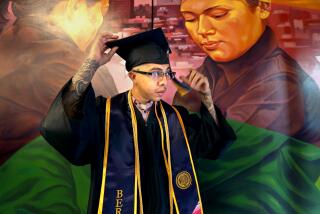Frat Trash : Think âAnimal Houseâ circa 1920. Then add a little class. An archeological dig uncovers fine china, womenâs clothes--and lots of liquor bottles--at Calâs Zeta Psi.
BERKELEY â No tattered togas were found, but archeologists digging through a Prohibition-era fraternity trash pit here have uncovered some other unusual artifacts, including evidence of a âBachelor Condiment Syndromeâ and a possible hazing device known as âthe Tub.â
The men of UC Berkeleyâs oldest fraternity also were fond of delicate demitasse cups, bootlegged liquor and, occasionally, womenâs clothing.
Welcome to âAnimal House,â 1920s-style.
This esoteric chapter of college history was unearthed--literally--a year ago, when a bulldozer began making way for a new wing of Calâs law school, Boalt Hall.
Up popped some broken ceramics (since nicknamed âfratwareâ) and out of a next-door research building sprang Laurie Wilkie, an assistant professor of anthropology, who saw the fragments from her office window.
After haggling with construction workers and university officials, she was granted 1 1/2 days to excavate the site. The haul: a laboratory full of old bottles, medicines, toothbrushes, bones and other relics from what one reporter called âthe not-so-ancient Greeks.â
âItâs trash,â Wilkie concedes, âbut historic trash.â
From it, she and her students have pieced together a sometimes amusing portrait of early 20th century fraternity life at Zeta Psi.
Consider, for example, the cache of 46 Del Monte catsup bottles. Maybe they were used for home-brewed beer, student Carolyn Luong says. But a more likely explanation is what she terms the Bachelor Condiment Syndrome.
âThe food [at the frat house] was so terrible that they had to douse it with catsup to make it edible,â she theorizes. That seems to be supported by a plethora of bones from cheap cuts of meat--and by assorted empty bottles of Pheno-Wafers, citrate of magnesium and other elixirs for an upset stomach.
The typical Zeta Psi guy might have washed away any lingering meal aftertaste with a swig of Listerine, Wilkie says, holding a bottle fragment stamped with the companyâs name. Then again, the mouthwash could have been used to camouflage gin breath.
Judging from the dozens of beer and booze bottles discovered--along with archival photos of fraternity brothers clutching steins and a keg in the hills above the campus--Prohibition failed to squelch the groupâs party life.
A Zeta Psi house manager from that era, John Thomas Beales, 90, says members purchased moonshine in nearby Emeryville--or prescription liquor in local pharmacies.
âSome of Berkeleyâs doctors didnât want [us] to risk getting contaminated products from the bootleggers . . . so they [wrote] prescriptions for a pint of 100-proof whiskey,â he recalls.
*
Among the more mysterious finds from the excavation site were a hat pin and some beads. At first, Wilkieâs team was baffled, because Zeta Psi had strict rules banning women on the property.
Then researchers combed through fraternity archives and ran across old photos of members wearing female clothing.
Beales insists there was âno cross-dressing in my day,â but Wilkie says such outfits were probably worn during skits and parties.
Also retrieved from the frat-house garbage pit were teacups, fine china and demitasse glasses emblazoned with the Zeta Psi crest.
Here, at last, was a possible indication of a more refined side of Greek life. After all, Zeta Psiâs early members typically came from well-to-do homes, Wilkie notes. And alumni include financial planner Dean Witter, who died in 1969.
Perhaps the brothers spent their evenings discussing literature and philosophy while sipping coffee from dainty demitasse cups.
âThey were more genteel then,â suggests Julian Zajfen, president of Zeta Psiâs current Berkeley incarnation. âThey had specific sets of teacups and china. We donât have any of that.â
Then again, it isnât entirely clear how that elegant fratware was used.
âI wonder,â Wilkie says, noting that the demitasse cups were âshot-glass-sizedâ and that all were found broken. Besides, itâs hard to imagine serious intellectual debates going on in a frat house that also allowed--according to diary entries from Zeta Psi archives--boxing matches indoors.
The groupâs original wooden house, built in 1870 and abandoned in 1911, was in such sorry shape toward the end that guests were never taken upstairs and recruitment of new members was hampered, says Trushna Parekh, an archeology student who examined the house history for Wilkieâs class.
Part of the destruction was attributable to a much-feared cast iron tub in the basement.
âTubbing,â says former member Beales, involved dragging a freshman downstairs, stripping off his clothes and briefly holding him underwater in the tub.
âIt was a discipline imposed by upperclassmen,â he says. âIt happened to me once. I have no idea [why].â
Wilkie says rumors abound that substances other than water were in the tub. The Zeta Psi diary describes people âresisting tubbing to the extent of tearing doors off hinges and ripping stair railings from the walls,â Parekh reports.
When the fraternity moved to a custom red-brick building in 1911, the tub went with it, but improved maintenance apparently kept that house--which is now the universityâs archeological research center--in better repair.
Some rooms had themes and nicknames, such as âthe Cave,â âthe Shipâ and âthe Roughhouse Room.â Out back, according to archival photos, members dug a trash pit, the one later excavated by Wilkie. The reason for it is a mystery.
âWe had good garbage service,â says Beales, who joined Zeta Psi in 1925, a few years after the pit was created.
Maybe the idea was to surreptitiously dispose of illegal liquor bottles, Wilkie theorizes. But that doesnât explain all the non-booze artifacts buried there, including a bone-handled toothbrush too large to reach the back teeth.
(Brushing was just becoming popular among societyâs upper crust at the time, she says, but only for cosmetic purposes, so there was no need to clean anything but the front teeth.)
In any case, Wilkie concludes, the pit offers a rare look at how âa part of Californiaâs elite prepared for adulthood.â
And its treasure, she adds, may be one of a kind:
âIâve never heard of any other fraternity excavations. It doesnât seem to be a hot sub-discipline within archeology.â
More to Read
Sign up for Essential California
The most important California stories and recommendations in your inbox every morning.
You may occasionally receive promotional content from the Los Angeles Times.










